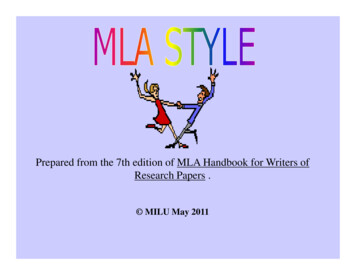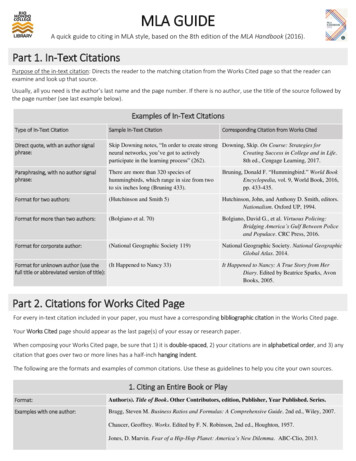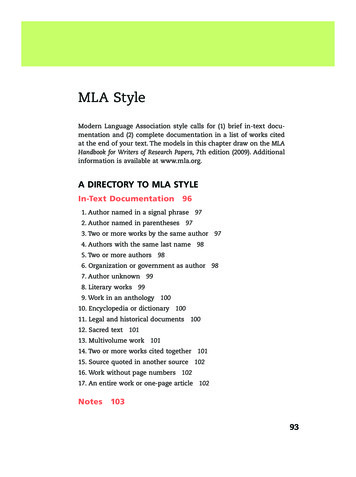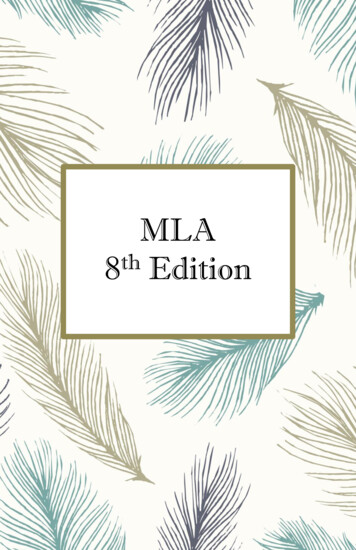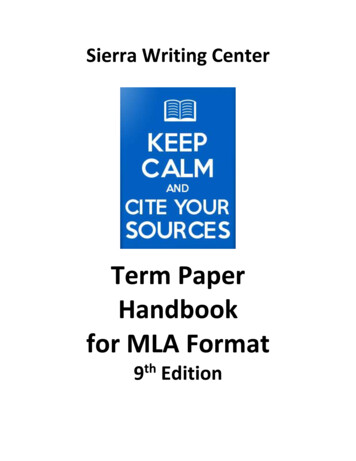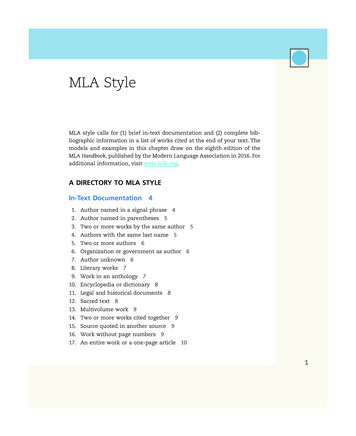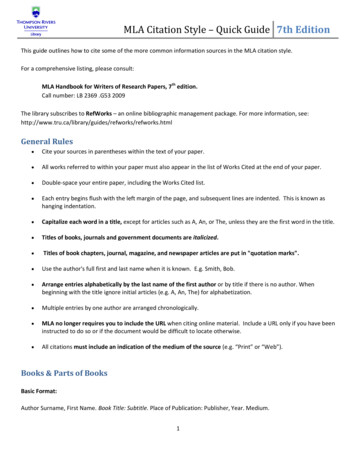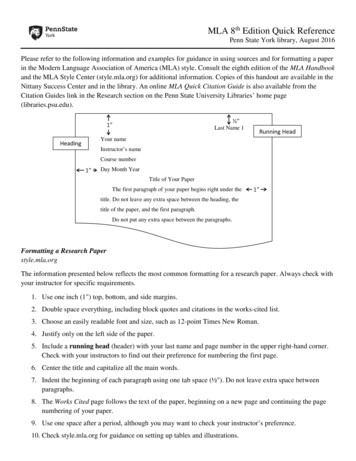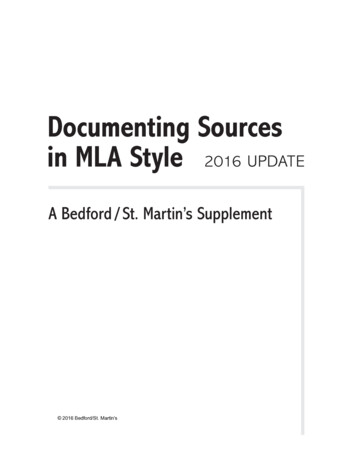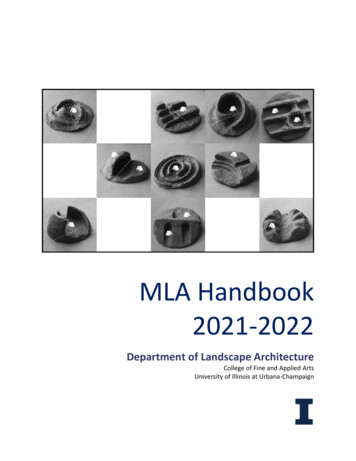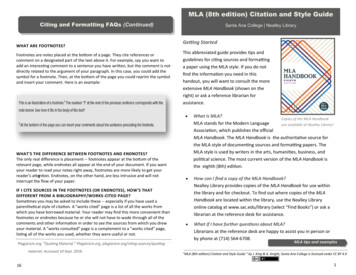
Transcription
MLA (8th edition) Citation and Style GuideCiting and Formatting FAQs (Continued)WHAT ARE FOOTNOTES?Footnotes are notes placed at the bottom of a page. They cite references orcomment on a designated part of the text above it. For example, say you want toadd an interesting comment to a sentence you have written, but the comment is notdirectly related to the argument of your paragraph. In this case, you could add thesymbol for a footnote. Then, at the bottom of the page you could reprint the symboland insert your comment. Here is an example:WHAT'S THE DIFFERENCE BETWEEN FOOTNOTES AND ENDNOTES?The only real difference is placement -- footnotes appear at the bottom of therelevant page, while endnotes all appear at the end of your document. If you wantyour reader to read your notes right away, footnotes are more likely to get yourreader's attention. Endnotes, on the other hand, are less intrusive and will notinterrupt the flow of your paper.IF I CITE SOURCES IN THE FOOTNOTES (OR ENDNOTES), HOW'S THATDIFFERENT FROM A BIBLIOGRAPHY/WORKS-CITED PAGE?Sometimes you may be asked to include these -- especially if you have used aparenthetical style of citation. A "works cited" page is a list of all the works fromwhich you have borrowed material. Your reader may find this more convenient thanfootnotes or endnotes because he or she will not have to wade through all of thecomments and other information in order to see the sources from which you drewyour material. A "works consulted" page is a complement to a "works cited" page,listing all of the works you used, whether they were useful or not.Plagiarism.org. “Quoting Material.” Plagiarism.org, plagiarism.org/citing-sources/quotingmaterial. Accessed 10 Sept. 2016.16Santa Ana College Nealley LibraryGetting StartedThis abbreviated guide provides tips andguidelines for citing sources and formattinga paper using the MLA style. If you do notfind the information you need in thishandout, you will want to consult the moreextensive MLA Handbook (shown on theright) or ask a reference librarian forassistance. What is MLA?Copies of the MLA HandbookMLA stands for the Modern Languageare available at Nealley Library!Association, which publishes the officialMLA Handbook. The MLA Handbook is the authoritative source forthe MLA style of documenting sources and formatting papers. TheMLA style is used by writers in the arts, humanities, business, andpolitical science. The most current version of the MLA Handbook isthe eighth (8th) edition. How can I find a copy of the MLA Handbook?Nealley Library provides copies of the MLA Handbook for use withinthe library and for checkout. To find out where copies of the MLAHandbook are located within the library, use the Nealley Libraryonline catalog at www.sac.edu/library (select “Find Books”) or ask alibrarian at the reference desk for assistance. What if I have further questions about MLA?Librarians at the reference desk are happy to assist you in person orby phone at (714) 564-6708.MLA tips and examples"MLA (8th edition) Citation and Style Guide " by J. King & A. Knight, Santa Ana College is licensed under CC BY 4.01
Why do I need to cite sources?Aside from your professors requiring that you cite your sources,citing sources allows readers or audiences of your work to see whatinformation sources you consulted or considered in your research.Also, since citations include author, title, and other important publication information, your readers can look up your sources if theywish to explore them further on their own. Citing your sources isn’tjust something to do to get a good grade; you could be potentiallyintroducing new sources of information and ideas to your reader/audience. Another way to look at citing sources involves seeing eachsource as a unique perspective or voice that you incorporate withyour own ideas. Through your research, you are communicating yourunique understanding of a topic, based on the information sourcesyou’ve discovered. What’s more, you’re making a contribution to alarger conversation related to your research topic.Questions? Ask a librarian!Nealley Librarians are happy to assist you withquestions you have about citing sources and formatting yourresearch projects. Visit the reference deskor call (714) 564-6708.2Modern Language Association. “Formatting a Research Paper.” MLA Style Center Website, 2016,http://style.mla.org/formatting-papers/ The information on this page is provided by the Modern Language Association’s MLA Style Center website, as cited below.What does it mean to cite sources?To cite a source means to credit the information and ideas of othersshared in your work. For example, you may decide to include a statistic or a theory developed by a scholar in your paper. Whether youdirectly quote (word-for-word) an information source or share someone else’s idea in your own words, you need to credit the originalauthor or creator.NOTE: List citations alphabetically, according to the first name or element listed for each citation. How to format the Works Cited list at the end of your paper:Basic Concepts of Citing Sources15
14Below are the core elements of MLA citations necessary for properly citingprint and electronic (online) resources, including books, articles, websites,and other information sources.How to format the second page and subsequent pages of your paper:NOTE: A separate title page is not necessary unless your instructor requires one.How to format the first page of your paper:Paper Formatting TipsCore Elements of MLAThese elements are listed in the order they should appear in your citations.Please keep in mind that each information source and citation is unique. Notevery element listed below may be available for the different informationsources you reference in your research.ContainersCore ElementsFor additional information aboutcontainers, see pp. 30-36 in theMLA Handbook (8th ed.).Containers hold a collection of information. For example, books can contain collections of poems, essays, orchapters and websites can containarticles and postings. If you were tocite a short story contained in a bookor anthology, the short story would beconsidered the source (2), and theanthology the container (3) (ModernLanguage Association). Another example of containers includes periodicals (e.g., journals, magazines, andnewspapers) that contain collectionsof articles. In most cases, you will beciting a specific article you read withina periodical (e.g., an article from theLos Angeles Times). In which case, thetitle of the article would count as thetitle of source (2), and the title of theperiodical (Los Angeles Times) wouldbe listed as the container (3).Modern Language Association. “Works Cited: A Quick Guide.” MLA Style Center Website,2016, style.mla.org/works-cited-a-quick-guide/3
Citing and Formatting FAQsIdentifying Book Citation ElementsCore ElementsCoates, Ta-NehisiChapter or essay title (for anthologies oredited book compilations)Book title (Between the World and Me)Sample book coverBook editor(s), information, if availableBook edition information, if availableCopyright /publication dateand publisherinformation is often foundwithin the first fewpages of the book.Volume and issue number, if availableSpiegel & Grau2015Page numbers (for citing a specific chapter), URLor DOI (digital object identifier) for e-resourcesBook CitationWHAT IS QUOTING?Taking the exact words from an original source is called quoting. You should quotematerial when you believe the way the original author expresses an idea is the mosteffective means of communicating the point you want to make. If you want toborrow an idea from an author, but do not need his or her exact words, you shouldtry paraphrasing instead of quoting.HOW OFTEN SHOULD I QUOTE?Most of the time, paraphrasing and summarizing your sources is sufficient (butremember that you still have to cite them!). If you think it’s important to quotesomething, an excellent rule of thumb is that for every line you quote, you shouldhave at least two lines analyzing it.HOW DO I INCORPORATE QUOTATIONS IN MY PAPER?Most of the time, you can just identify a source and quote from it, as in the firstexample above. Sometimes, however, you will need to modify the words or formatof the quotation in order to fit in your paper. Whenever you change the originalwords of your source, you must indicate that you have done so. Otherwise, youwould be claiming the original author used words that he or she did not use. But becareful not to change too many words! You could accidentally change the meaningof the quotation and falsely claim the author said something they did not.WHAT'S A WORKS CITED PAGE?A works cited page or bibliography is a list of all of the sources you have used in theprocess of researching your work. In general, a bibliography should include: the authors' namesthe titles of the worksthe names and locations of the companies that published your copies of thesourcesthe dates your copies were publishedthe page numbers of your sources (if they are part of multi-source volumes)(as it should appear in a Works Cited list)OK, SO WHAT'S AN ANNOTATED BIBLIOGRAPHY?Coates, Ta-Nehisi. Between the World and Me. Spiegel & Grau,2015.4An annotated bibliography is the same as a bibliography with one importantdifference: in an annotated bibliography, the bibliographic information is followedby a brief description of the content, quality, and usefulness of the source.(FAQ’s Continued on page 16)13
In-Text Citation ExamplesAuthor’s name in text withquotationAuthor name in textwithout quotationGaleano asserts that the rise in coffeeprices, world wide, “did nothing to easethe chronic poverty of Brazilian coffeeworkers “ (280).Angela Davis’ book Are Prisons Obsolete?provides a history of the development ofthe U.S. prison system (22-45).Author name in citation withpage numberPoetry can be used as an inspirationallearning tool (Williams 78).Author name in citation withoutpage number (for when no pagenumbers are provided)The blog, “EducationQuest,” provides avariety of self-care tips for college students(Ourada).Two source authors in citationFor fuller understanding, readers shouldresearch the relevant culture and history(Said and Do 6).Citation Examples for Works Cited PageThe following examples demonstrate how full citations should appear within theworks cited page, located at the end of your paper or project. For tips on how toformat your works-cited page, please see p. 15 in this guide.Referencing Print BooksBasic FormName of author or editor. Title of the Book. Publisher name, Year published.Book (One Author)Rowling, J.K. Harry Potter and the Goblet of Fire. Levine-Scholastic, 2004.Book (Two or Three Authors)Quotation found in indirectsource (for quoting a source citedin another source)Octavia Butler writes, “destiny is to takeroot among the stars” (qtd. in Brown andImarisha 1).Video source (note– you mustinclude the time slot from whichyou are quoting; here, the time isfrom minute, 1 minute, 26 seconds. to 1 minute, 29 secs.)The music video for M.I.A.’s song“Borders,” depicts refugees climbing wirefences in a desert and positioned to spellout “Life” (00:01:26-00:01:29).Kirkpatrick, Jim and Paul Caldwell. Eating Disorders: Everything You Need to Know.Firefly Books, 2004.Book (More than Three Authors)Ellis, David B. et al. Becoming a Master Student. Houghton Mifflin, 2006.Book (Corporate Author)American Psychiatric Association. Diagnostic and Statistical Manual of MentalDisorders: DSM5. 5th Ed. American Psychiatric Association, 2013.Article in a Reference Book“Civil Disobedience.” Encyclopedia Americana. International Edition. ScholasticLibrary, 2004.Multivolume WorkQuoting, Paraphrasing, and Avoiding PlagiarismIt is important to credit the information sources you use that provide newideas to you for your research. Whether you directly quote (word-for-word)something from an information source (even online sources) or paraphraseanother’s idea you in your own words , you must provide an in-text (orparenthetical) citation.Writing assistance is available at the SAC Learning Center.Sign up online at: rey, R. J. “Bulimia Nervosa.” The Gale Encyclopedia of Mental Disorders. Ed E.Thackeray and M. Harris. Vol. 1. Gale Group, 2003. pp. 153-62.Quick Formatting Tips for the Works Cited Page: Begin the Works Cited list on a new page at the end of your paper or project. Citations should be double-spaced. Second and subsequent lines of citations should be indented 1/2 inch fromthe first line. This is called a “hanging indent” and there are many YouTubevideos that demonstrate this.5
In-Text (Parenthetical) CitationsCitation Examples (Continued)Referencing Print Periodical ArticlesWhat Are In-Text Citations?In-text (parenthetical) citations appear throughout your paper or project and creditBasic Form:Name of author or editor (if given). “Title of the article.” Publication title, Volume,Number (if applicable), Date Month Year: Page number.Magazine or Newspaper ArticleCarroll, Aaron E. “Sorry, There’s Nothing Magical About Breakfast.” New York Times,23 May 2016: C8.Journal Articleideas and direct quotes you borrow from different information sources. In-text citations are shortened versions of the full citations you provide at the end of your paper or project in the works cited list.ExampleIn-text citation:According to a recent article published in Mother Jones, thousands of peopleLorence, Mark. “School of Minecraft.” School Library Journal, Vol. 61, no. 4, 2015, pp.26-30.nationwide have actively protested the construction of the Dakota AccessPipeline in solidarity with Standing Rock Sioux tribal members (Sammon).Referencing Online SourcesOnline Book, Basic FormName of author or editor. Title of the Book. Database or sponsor. Publisher name,Year published.Sammon, Alexander. “The Next Keystone? Protesters Try to Stop AnotherHuge Oil Pipeline.” Mother Jones, 26 Aug. a-access-bakkenpipeline-protesters-sioux. Accessed 4 Sept. 2016.eBookPoe, Edgar Allan. The Murders in the Rue Morgue. eBook Collection (EBSCOhost),Generic NL Freebook Publisher, 1993.Magazine Article from a Library DatabaseZirin, Dave. “Time for the NCAA to Pay.” The Progressive, Jun. 2014, pp. 42. OpposingViewpoints in Context. search.ebscohost.com/login.aspx?direct true&db mth&AN 96327384&site ehost-liveJournal Article Basic FormName of author or editor. “Title of the Article.” Publication title Volume Number,Issue Number, year of publication, page numbers. Database. URL or DOIJournal Article from a Library DatabaseWashington, Myra. “The Post-Racial Mystique: Media and Race in the Twenty-FirstCentury.” Black Scholar, Vol. 46, no. 2, 2016, pp. 66-69. Psychology and6Corresponding works cited entry:Behavioral Sciences Collection. tinyurl.com/z3zblcoBasic Rules for In-Text Citations When possible, include the author’s last name and page number of theinformation source. Example: (Davis 25) Many online or electronic sources do not include page numbers. In thesecases, provide enough information in-text (e.g., author and title of work) toconnect your reader to the full citation in the works cited list. For online sources, do not include URLs (website addresses) in-text. Instead,include the first item of the full citation in the work’s cited list (e.g., author’slast name or name of authoring organization).For a more detailed explanation and examples of in-text citing,please see pp. 116-128 of the official MLA Handbook (8th ed.).11
Citation Examples (Continued)Citation Examples (Continued)Other SourcesReferencing Online Sources (Cont.)Newspaper Article from a Library DatabaseInterviewBag, Alice. Personal Interview. 2 Sep. 2016.Smith, Barbara S. “Reframing the Conversation on Growing Old.” Sarasota HeraldTribune [Sarasota, FL], 12 May 2015, pp. E.8. ProQuest Newsstand.DVD, BluRay, or VHStinyurl.com/zq4mlrlThe Jungle Book. Directed by Jon Favreau, Performances by Neel Sethi and BillEncyclopedia Article from a Library DatabaseMurray. Walt Disney Pictures, 2016.Howard, Lillie. “Zora Neale Hurston.” Dictionary of Literary Biography: AfroLecture, Speech, ReadingAmerican Writers from the Harlem Renaissance to 1940. Ed. Trudier Harris.Obama, Barack Hussein. “Obama Presidential Address.” Presidential Inauguration ofthe United States of America. Washington D.C. 24 Feb. 2009.PerformanceGale, 1987. Literature Resource Center. tinyurl.com/jg4hrbdWeb Site Basic FormName of author or editor (if given). “Title of Work.” Title of Web Site. Publisher orWheeldon, Christopher. “An American in Paris.” Segerstrom Center for the Arts.container of site, day month and year of publication – use n.d. if no date isavailable. URL . Date Accessed.25 Apr. 2017.Netflix (or Hulu, Google Play, Amazon Video, HBOGO, etc.)Website“AKA Smile.” Jessica Jones, season 1, episode 13, Marvel Television, 20 Nov. 2015.Anders, Charlie J. “Prince Was One of the Greatest Fantasy Storytellers of All Time.”Netflix, www.netflix.com/watch/80002324?trackId 13752289&tctx 0%i09.com. Gizmodo, 21 Apr. 2016. -52e6-41ea-95dc-70d28bb074d7-1212192421772302841. Accessed 6 May 2016.BlogAdditional Citation Tips & Examples McSweeney, Kelly. “How Tiny ‘Natural Nanobots’ Attack Cancerous Cells.” ZDNet, 6View the official MLA Handbook (8th ed.) — copies areavailable for checkout at the SAC Nealley Library. Ask areference librarian for assistance.Visit the extensive, online MLA guide created by PurdueUniversity’s Online Writing Lab 01Sep. 2016. www.zdnet.com/article/tiny-robots-attack-cancer/. Accessed14 Sep. 2016.Tweet@neiltyson. “There’s more than 300 metric tons of it embedded in every 500meter metallic asteroid that orbits the Sun. #ThatsGold.” Twitter, 18 Aug.102016, 6:17 PM. twitter.com/neiltyson/status/7664438437597224967
893a3b16MLA Style Guide (8th ed.)89A URL is not necessary for print articles.2Modern Language Association. “Formatting a Research Paper.” MLA Style Center Website, de-journal/3b3aAK & JK /Fall 2016The example below is from an article found within a library database and shows how to identify citation elements(article title, author, periodical title, page numbers, etc.) necessary for properly citing articles published injournals, newspapers, magazines, and other periodicals. A sample works-cited entry is also provided (under “FinalWorks-Cited-List Entry”). A similar citation structure would be used for a print article (omitting the URL).Identifying Article Citation Elements
MLA stands for the Modern Language Association, which publishes the official MLA Handbook. The MLA Handbook is the authoritative source for the MLA style of documenting sources and formatting papers. The MLA style is used by writers in the arts, humanities, business, and political science. The most current version of the MLA Handbook is
